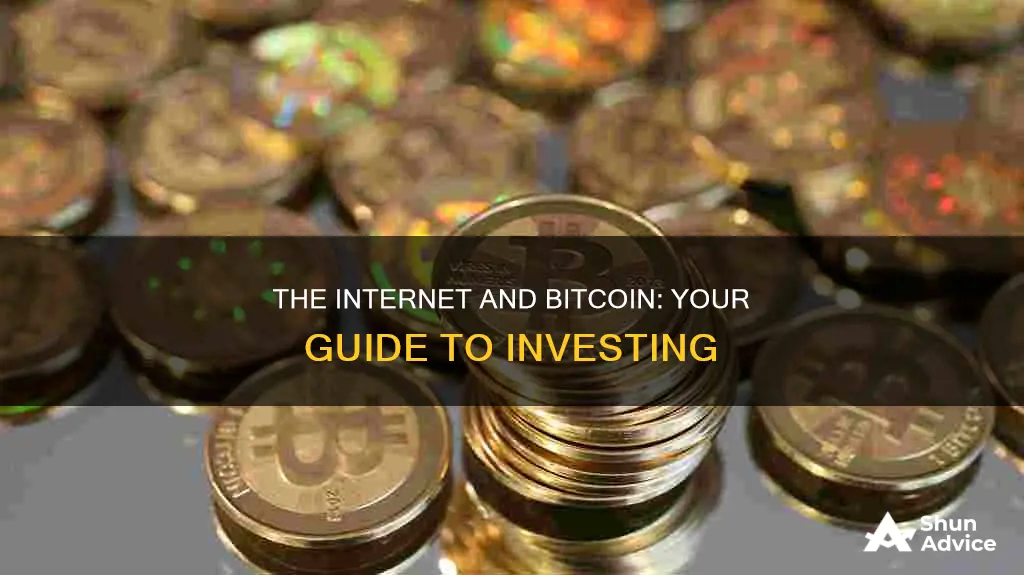
Bitcoin is a decentralised digital currency that operates without the oversight of banks and governments. It is one of the most widely used types of cryptocurrency, with virtual coins or tokens used instead of physical cash.
There are several ways to invest in Bitcoin, both directly and indirectly. Here are the steps to get started:
1. Choose a crypto-trading service or venue:
You'll need a crypto exchange where buyers and sellers meet to exchange dollars for coins. Examples include Coinbase, Binance, Kraken, and Gemini.
2. Connect your exchange to a payment option:
You'll need to connect your bank account, debit card, or credit card to the exchange. While you can use a credit card, it is not recommended due to high transaction fees and interest charges.
3. Place an order:
Almost all crypto exchanges offer market and limit orders, and some also provide stop-loss orders. Decide how much Bitcoin you want to buy, keeping in mind that it is a very high-risk and volatile investment.
4. Safe storage:
You'll need a digital wallet to store your Bitcoin. There are two types of wallets: hot wallets, which are online and more convenient, and cold wallets, which are offline and more secure. Examples of hot wallets include Electrum and Mycelium, while cold wallets include Trezor and Ledger.
It's important to note that investing in Bitcoin carries substantial risks due to its extreme volatility. Make sure to do your research and carefully consider your risk tolerance and investment strategy before investing.
| Characteristics | Values |
|---|---|
| Investment methods | Direct methods: purchasing standalone Bitcoin, Greyscale's Bitcoin Investment Trust, Amplify Transformational Data Sharing ETF, Bitwise 10 Private Index Fund |
| Indirect methods: investing in a company that utilizes Bitcoin technology, participating in Bitcoin mining | |
| Investment platforms | Cryptocurrency exchanges: Coinbase, Gemini, Kraken, Crypto.com, Binance, Robinhood, Webull, TradeStation, Fidelity |
| Traditional stockbrokers: Robinhood, Webull, TradeStation, Fidelity | |
| Robo-advisors: Crypto.com | |
| ETFs: Amplify Transformational Data Sharing ETF | |
| Investment trusts: Greyscale's Bitcoin Investment Trust | |
| Investment funds: Bitwise 10 Private Index Fund | |
| Investment requirements | Personal identification documents, bank account information, a secure internet connection |
| Investment risks | Volatility, pump-and-dump schemes, pyramid schemes, fraud, security breaches, lack of government regulation |
| Investment tips | Understand your risk tolerance, diversify your portfolio, start small |
| Investment strategies | Buy and 'Hodl' Bitcoin, hold Bitcoin long-term, trade Bitcoin on short-term volatility |
What You'll Learn

Choosing a Bitcoin exchange
- Regulations and security: Different exchanges comply with different laws and regulations based on their locations, practices, and offerings. Some exchanges have Know Your Customer (KYC) and Anti-Money Laundering (AML) practices, requiring participants to submit personal information. Many exchanges nowadays also ban customers residing in certain countries. It is also important to be aware of the reputation of each exchange and conduct research to ensure they are not involved in nefarious activities, hacks, and exit scams.
- Fiat compatibility: A fiat-compatible exchange allows users to transfer national currencies (e.g. USD, CAD) into the crypto world for trading use and vice versa. Some exchanges have different fiat options, and it is important to check which banks and fiat currencies are compatible with the exchange.
- Derivatives and leverage trading: Derivatives are trading products such as futures and options based on the price action of underlying spot assets. Derivatives exchanges often offer leverage trading, which allows traders to borrow funds for trades based on the amount of funds they hold on the exchange.
- Volume and liquidity: Trading platforms vary based on the number of participants using them and the amount of each asset being traded. This can affect how easily users can enter or exit positions. Low-volume exchanges may not have enough sellers to match a buyer's desired amount, forcing the trader to sell to lower offers on the exchange.
- Asset availability and fees: Top digital assets such as Bitcoin, Ethereum, and Litecoin are widely available on most crypto exchanges. However, smaller-cap coins and tokens may not be available on certain exchanges. Most exchanges charge a small fee for each trade, which varies based on the platform and is usually a percentage of each trade. Some exchanges also have withdrawal fees and limits.
- User experience and customer service: An exchange with an intuitive interface and good user experience makes it easier to trade cryptocurrencies. Additionally, it is important to consider the customer service and other customer-related functionalities offered by the exchange.
Some popular cryptocurrency exchanges that allow users to buy and sell Bitcoin include:
- Binance: The most powerful cryptocurrency exchange in the world, with a trading volume of over $13 billion per day and access to hundreds of coins and tokens.
- Coinbase: One of the most widely used digital currency trading exchanges, especially for traders in the United States. It offers a user-friendly platform, strong security, and advanced trading options.
- Kraken: One of the oldest trading platforms in the crypto space, offering access to hundreds of cryptocurrencies, fiat compatibility, and other cryptocurrency trading services.
- CEX.io: Features an excellent user interface, making it a good platform for beginners, and allows users to access a wide range of cryptos.
- Crypto.com: Provides an extensive digital asset trading and investing ecosystem, supporting over 350 cryptocurrencies. The Crypto.com mobile app offers a wide range of products and features, making it a good option for mobile crypto trading.
A Beginner's Guide: Buying Bitcoin on Circle Invest
You may want to see also

Getting a Bitcoin wallet
Choose the Right Bitcoin Wallet
The first step is to select a Bitcoin wallet that suits your needs. There are three basic types of wallets: software wallets, hardware wallets, and custodial wallets. Software wallets, also known as hot wallets, store your cryptocurrency on an internet-connected device such as your mobile phone or laptop. Hardware wallets, also known as cold wallets, are specialised pieces of hardware that keep your cryptocurrency offline. Custodial wallets, on the other hand, leave your cryptocurrency in the control of a trusted company, such as a crypto exchange.
Download a Wallet App
Once you've decided on the type of wallet, download a wallet app to your phone or computer. Popular options include Coinbase Wallet, Exodus, Electrum, and Trust Wallet. Make sure to download the app from the official app store or the wallet provider's website to avoid malicious software.
Create an Account
After downloading the app, create an account by providing basic information such as your name, email address, and a strong password. Some wallet apps may also require identity verification, such as submitting a government-issued ID and a selfie. It is recommended to use two-factor authentication (2FA) for added security.
Set Up Security Features
As part of the account creation process, you will need to set up security features, including a recovery or seed phrase. This is a random 12-word or 24-word phrase corresponding to your private key. Keep this phrase in a secure location, as it will be needed to access your funds if you lose your login credentials or want to retrieve them on another device.
Transfer Cryptocurrency to Your Wallet
Now that your Bitcoin wallet is set up, you can start using it by transferring cryptocurrency from another wallet or exchange. You can also purchase cryptocurrency directly through the app, using a bank account or credit card.
By following these steps, you can securely and safely get started with your Bitcoin wallet, allowing you to store, send, and receive Bitcoin and other cryptocurrencies. Remember to always do your research, stay informed about the latest security measures, and only invest what you can afford to lose.
Bitcoin's Winklevoss Twins: Millions Invested, Billions Made
You may want to see also

Connecting your wallet to a bank account
Step 1: Choose a Reliable Platform and Register
Firstly, select a reputable cryptocurrency platform that supports SEPA/SWIFT transfers. Research user reviews, security features, and fees to ensure the platform is trustworthy. Check that the platform offers fully insured funds and low fees. If you don't already have an account, you'll need to register and complete the verification steps, including a KYC (Know Your Customer) check and providing identification documents.
Step 2: Transfer Cryptos to Exchange
Once registered, you can buy or add Bitcoin to your account. Use the 'Buy' or 'Deposit' function in the trading section of the platform. You can use a credit/debit card to buy crypto, or use the exchange's deposit address to initiate a transfer from your personal Bitcoin wallet. After the purchase or deposit is confirmed, select the 'Sell' or 'Trade' function.
Step 3: Trade or Sell Crypto
With the 'Trade' function, look for the trading pair that corresponds to Bitcoin and your desired fiat currency (e.g. Bitcoin/USD or Bitcoin/EUR). Place a sell order, ensuring you are selling the correct amount of Bitcoin or crypto. Then, use the 'Withdraw' function to transfer your fiat money to your bank account.
Alternatively, with the 'Sell' function, you can sell your crypto directly to your bank account. Once the sell order is executed, the platform will convert your Bitcoin into the chosen fiat currency and send it to your account.
Step 4: Add Bank Details
Enter your bank account details, including the IBAN number for SEPA transfers or the SWIFT/BIC code for SWIFT transfers. Always verify the accuracy of the information before proceeding.
Step 5: Monitor the Transfer
The platform will process your withdrawal request, and the processing time will depend on the platform and the type of transfer. Monitor your bank account periodically until the transfer is complete.
Important Considerations:
- Be mindful of fees: Research and compare different platforms to find the most cost-effective option. There may be network fees, exchange fees, and withdrawal fees involved.
- Fluctuating exchange rates: Keep an eye on exchange rates as they can impact the final amount received.
- Security: Ensure your bank account details are accurate to avoid any transfer issues.
- P2P transfers: While not discussed in detail here, P2P transfers are another option for exchanging crypto for fiat currency. However, they come with certain risks, including potential fraud and payment delays. Always research and exercise caution when using P2P platforms, and never release your crypto until you receive fiat money in your bank account.
Bitcoin Investment: Is It a Profitable Venture?
You may want to see also

Placing your Bitcoin order
Now you’re ready to purchase Bitcoin. Your chosen cryptocurrency exchange will guide you through the process of placing your Bitcoin order. The big question is, how much Bitcoin should you purchase?
Some coins cost thousands of dollars, but exchanges often allow you to buy fractions of a single coin—your initial investment could be as low as $25.
Investing in Bitcoin is very risky, and it’s important that you carefully determine your risk tolerance and review your investment strategy before you purchase any Bitcoin.
If you’re using a platform like Robinhood, you can place your order by tapping a button or entering Bitcoin’s ticker symbol: BTC. Next, input the amount you want to invest. If Bitcoin’s current price is around $40,000, you’d need to invest that much to buy 1 BTC. If you invested less, say $1,000 when 1 BTC equals $40,000, you’d get a percentage of a Bitcoin equal to about 0.025 BTC.
If you’re using an exchange like Coinbase, you can place your order by linking your bank account, debit card, or credit card.
If you’re using a payment processor like PayPal, you can buy bitcoin by connecting your account to a debit card or bank account, or by using the balance of the PayPal account to purchase cryptocurrencies from a third-party provider.
If you’re using a credit card to buy bitcoin, be aware that credit card processing can tack on extra charges to such transactions. In addition, if you use a credit card to buy cryptocurrency, it generally will count as a cash advance and be subject to a higher interest rate than you pay on regular charges.
It’s generally advisable to pay for cryptocurrency purchases with cash or with another crypto you own.
Building Bitcoin City: A Guide to Investing
You may want to see also

Managing your Bitcoin investments
- Join a Bitcoin Exchange: To buy and sell Bitcoin, you'll need to join a cryptocurrency exchange, such as Coinbase, Binance, Kraken, or Gemini. These exchanges act as the middlemen of cryptocurrency investing, similar to a stock brokerage.
- Get a Bitcoin Wallet: You'll need a "hot wallet" or a "cold wallet" to store your Bitcoin. A hot wallet is provided by your cryptocurrency exchange or a third-party provider and is accessible via the internet. A cold wallet, on the other hand, is an actual piece of hardware, similar to a flash drive, that stores your Bitcoin offline and is considered more secure.
- Connect Your Wallet to a Bank Account: Link your Bitcoin wallet to your bank account to enable the purchase and sale of coins. Alternatively, you can link your bank account directly to your cryptocurrency exchange account.
- Place Your Bitcoin Orders: Decide how much Bitcoin you want to buy or sell based on your risk tolerance and investment strategy. Remember that Bitcoin is a highly volatile asset, and its value can fluctuate dramatically over a short period. You can purchase fractions of a single coin, with some exchanges allowing investments as low as $25.
- Manage Your Bitcoin Investments: You can use your Bitcoin for online transactions, hold it for the long term, or perform day trading. Your cryptocurrency exchange will provide the tools necessary for buying and selling coins. Consider your investment goals and risk tolerance when deciding on a strategy.
- Diversify Your Portfolio: Bitcoin is a high-risk investment due to its volatility. To mitigate risk, diversify your portfolio by investing primarily in low-risk assets like government bonds or index funds and allocating a smaller portion to high-risk investments like Bitcoin.
- Start Small: If you're new to Bitcoin investing, consider starting with a small amount, such as investing a fixed amount regularly. This way, you can gain exposure to Bitcoin without taking on too much risk.
- Long-Term vs. Short-Term Strategies: There are different investment strategies for Bitcoin, including buying and holding for the long term, trading on short-term volatility, or employing a combination of both. Long-term investors focus on holding Bitcoin for extended periods, believing in its potential as a store of value. Short-term traders aim to capitalise on Bitcoin's volatility by buying and selling frequently.
- Be Aware of the Risks: Bitcoin investing carries significant risks due to its volatility and lack of regulation. There is a possibility of losing money, and it's important to be cautious and informed before making any investment decisions.
Bitcoin Investment: Smart Move or Risky Gamble?
You may want to see also
Frequently asked questions
First, you'll need to determine where you want to make a Bitcoin purchase. Most Bitcoin investors use cryptocurrency exchanges. There are several different exchanges that facilitate Bitcoin transactions, including Coinbase, Binance, Kraken, and Gemini. Once you've chosen an exchange, you'll need to fund your account and place your first order. You can purchase a whole Bitcoin or a fraction of one, so your initial investment could be relatively low. After purchasing, you can decide whether to use your Bitcoin to make online transactions, hold it long-term, or perform day trading.
Bitcoin is a very high-risk and volatile investment. Its value may rise or fall dramatically in a very short period, even within a few hours or days. There is no central regulator ensuring the value remains stable, and its value is not linked to the profits of any one corporation but is dependent on market demand. Bitcoin is also prone to "pump-and-dump" schemes, where predatory investors reach out to amateur investors and convince them to pour money into Bitcoin, causing a surge in prices before they sell all their holdings and cause the value to plummet.
You can store your Bitcoin in a "hot wallet" or a "cold wallet." A hot wallet is operated by either your cryptocurrency exchange or a third-party provider and is accessible via the internet or a software program. However, hot wallets are not the most secure form of storage and are susceptible to hacking. A cold wallet, on the other hand, is a physical hardware device that stores your Bitcoin offline, similar to a flash drive. Cold wallets are considered the safest storage method and typically cost between $60 to $100.







